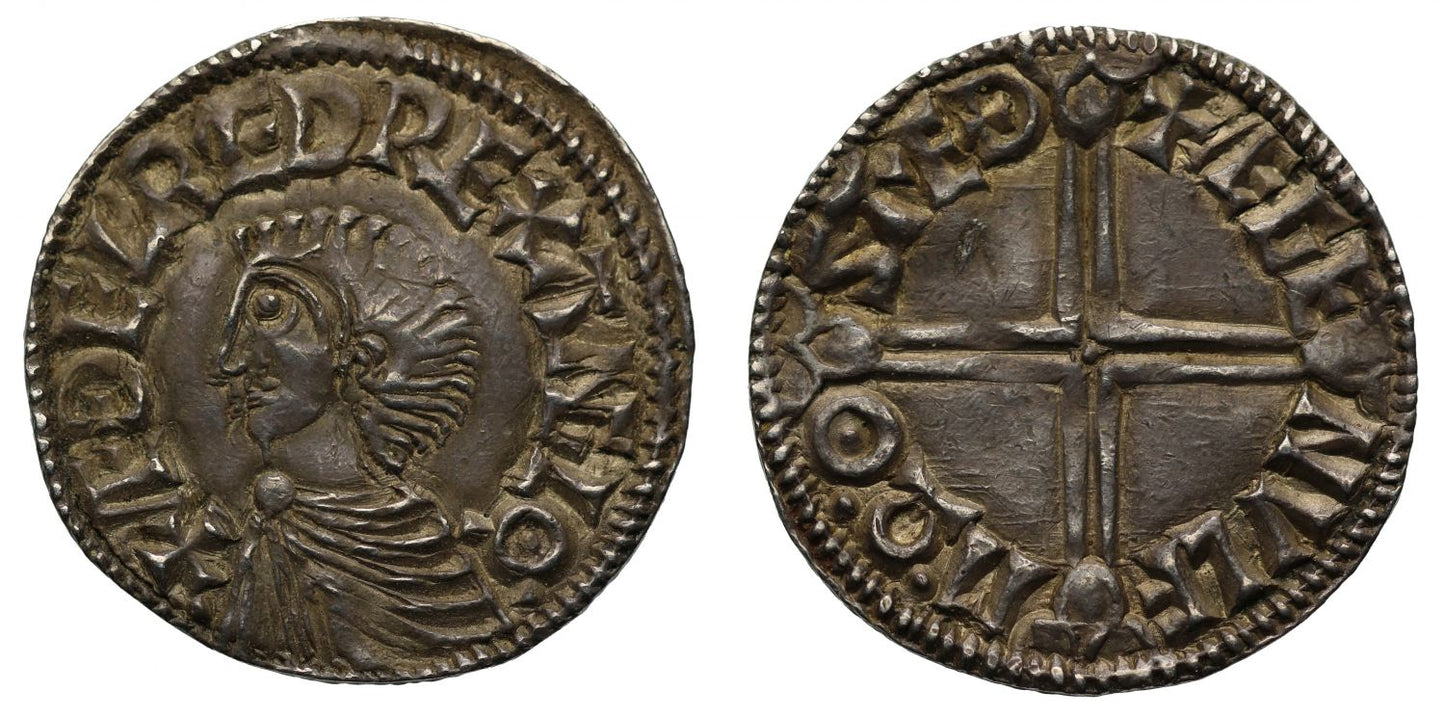FAQs
What makes a coin valuable?
I have coins to sell, what’s the next step?
How will my purchases be shipped?
What happens if I’m not entirely happy with my purchase?
Aethelred II Penny, long cross type, Stafford Mint, moneyer Aegenwulf
Aethelred II (978-1016), silver long cross Penny (c.997-1003), Stafford Mint, Moneyer Aegenulf, draped bust left Latin legend and beaded outer border surrounding both sides, legend commences lower left, +ÆÐELRÆD REX ANGLO, the NG ligatured, rev. long voided cross with tri-crescent ends, +ÆGE NVLF M.Ω.O STÆÐ, weight 1.75g (BMC IV, p.197; BEH 1740; SCBI 17:251 Midlands; N.774; S.1151). Toned with a few pecks, obverse a little off-centre, a bold very fine and appears to be the only example in private hands of this moneyer and type for the reign, extremely rare.
North lists 73 named mints in operation during the reign of Aethelred II with a further 14 unallocated. According to North Stafford operates with three moneyers only in the latter four types from CRVX to last small cross.
Though Aethelred enjoyed such a long reign he was known as "The Unready" literally meaning ill-counselled from a history of bad advice and decision making. Born circa 967 Aethelred was supported by his mother and partisans that were led by Earl Aelfhere of Mercia; ascending the throne at no more than 12 years of age after the murder of his Half-Brother Edward at Corfe. The influential Aelfhere having died in 983 meant Aethelred became more vulnerable, and the Vikings began to start their raids once again. Aethelred chose to pay off the raiders rather than resist, becoming known for giving such ransoms payments willingly. This meant many hundreds of thousands of coins ended up being taken to Scandanavia where they were hoarded and why much of the coinage that survives today often exhibits "peck marks" where the Viking bankers have inserted a knife point to make sure the metal quality was good. The harrying continued until Swein Forkebeard held a great swathe of England by 1013, and Aethelred was under threat in London retreating to the Isle of Wight. England submitted to Swein but he died suddenly on the 2nd February 1014 at Gainsborough giving Aethelred the advantage and driving the Vikings out. Canute the second son of Swein, returned to attack in 1015 and by early 1016 was marching on Mercia, Aethelred however passed away on 23rd April 1016 in London at around the age of 52 just as his second son Edmund was moving south to link up with the army. Edmund was elected King, but the army was his priority, and after winning a few battles suffered a defeat at Ashingdon on 18th October 1016. He retreated possibly wounded to West Mercia and negotiated a treaty giving him rule of Wessex. However, Edmund died in Oxford on the 30th November 1016 giving control to Canute.
Stafford on the River Stowe a tributary from the Trent is 28 miles west of Derby and was fortified by Aethelflaed the Lady of the Mercians barring entry into Mercia. Later in 1016 Edmund Ironside marched into the town and later still a castle was built in 1069 by William I.
The legends translate as "Aethelred, King of the English" and "Aegnulf of Stafford."
Provenance:
Ex P. W. P Carlyon-Britton, first portion, Sotheby, 17th November 1913, lot 516 part
Ex F. Elmore-Jones, Glendining, 13th May 1971, lot 776 - sold for £115.
Ex Collection of an English Doctor, part one, Sovereign Rarities, London, March 2022.
FAQs
What makes a coin valuable?
I have coins to sell, what’s the next step?
How will my purchases be shipped?
What happens if I’m not entirely happy with my purchase?













